- The upper Sepik area is from the mouth of the river, including the Murik Lakes.
- The Middle Sepik is from Kambrambo to Ambunti.
- The Lower Sepik is up stream of Ambunti.

From interior of Sendam Kamasan (cult haus), Darapap village, 1981.

Kataket (snake) hook suspended through a painted bark disc (and screened by palm leaves and feathers) holding three hand drums and a small carved figure.
Bungabwar Taab (cult haus), Janeainemot village.
Owned by Peter Kanari.

Brags (ceremonial masks) on display: Maio, Agra, Maro and Tarego.
Resting along side the garamut drum Awako in Mangei’i Kamasan (cult haus).
Big Murik village, 1981.

Brags (masks) from Numarum cult haus, Darapap village, 1981.
For details see Ruff W & Ruff R, "Villages and Sites of Murik Lake, Papua New Guinea", 1981.

Old brag (ceremonial mask) named Gweim now in the National Museum and Art Gallery of Papua New Guinea, Port Moresby, PNG.
The famous Gweim was retrieved by the museum in 1972 from a shipment intended for sale overseas, by an artifact dealer operating in PNG.
It is illustrated in The Seized Collection, 1972, with text by Dirk Smidt, #53 p 53.
A new replacement mask for this old brag has been carved for the Sendam cult haus, Mendam Village, Murik Lake.
The original Gweim however, was carved by Wiki well before the Germans came. It was considered an evil mask, and killed many men and women, so villagers got rid of it by passing it on to Arero. From him, it was subsequently inherited by a man who would now be in his 60’s, the 7th generation descendant of Arero.
Arero left Mendam because he believed that Mendam people had poisoned and killed his son Kusima. He was looking for a means of revenge. When he came to the place Gapun, the people were involved with a sing-sing, connected with the stone spear that accompanies Gweim.
Arero gave them a dog’s head in an "adze basket". They gave him the mask, along with the stone "spear"... and returned the "adze basket" after the ceremony.
Arero’s clan is Mangaren – and when these clan members are angered by opposition clans, they perform the ceremony which activates Gweim Brag against them.
Craig, B - "Report for the Papua New Guinea National Museum and Art Gallery, of a Field Trip to the Sepik, Oct 19 - Nov 29, 1981", 1981, p 168 (6a).

Drawing taken from a rubbing of a tortoise shell arm band, Darapap village.
In Numarum cult haus, the shell was the base for a figure nambed Agogo, brought by the ancestors from their first settlement at Bok, in the Murik area, about 180 years ago.
The arm band was originally from Boem Island people.
Craig, B - "Report for the Papua New Guinea National Museum and Art Gallery, of a Field Trip to the Sepik, Oct 19 - Nov 29, 1981", 1981, pp 153-154.

Motifs from a spear which belonged to Gambei and Sana of Karau.
Ninety notches on the spear indicate the number of victims taken by the original owners, "Who were fierce warriors who killed men, women and children walking along the beach, even their own people!"
The spear is now owned by Matthias Wapo, and is housed in the Darapap village Numarum Taab (cult haus).
Craig, B - "Report for the Papua New Guinea National Museum and Art Gallery, of a Field Trip to the Sepik, Oct 19 - Nov 29, 1981", 1981, p 156 (22).

Motif from an old spear, Darapap village.
The name of this spear is Nakorub. (D. Lipset).
The spear originally came from a place named Sanai which existed before the split of Karau/Mendam/Darapap villages into separate entities.
Araro of Mangaren clan was the owner. Araro married a Sait group wife, and when the Kopar Sait people joined those of Karau, they brought the spear with them. (Boraman was the name of the beach village from which they came 200 years ago).
Now the spear is owned by Ginau and kept in Numarum Taab (cult haus).
Craig, B - "Report for the Papua New Guinea National Museum and Art Gallery, of a Field Trip to the Sepik, Oct 19 - Nov 29, 1981", 1981, p 156 (22).

Lower Sepik/Ramu River mask with black and ochre colours, incised details in cheek and forehead area.
Private collection, U.S.A.
Purchased in 1962 from a German artefacts dealer.

Various views of a Lower Sepik/Ramu River standing figure.
Shell eyes and incised details on chest and face, embellished with fibre and feathers.
Private collection, USA.
Purchased in 1962 from a German artefacts dealer.

Ruff drawing of a bark painting, after Buhler, Barrow & Mountford - "Art of the South Sea Islands", Crown Publishers, New York, 1962, p 56.
Designated a "painting from a cult haus at Kambrambo, lower Sepik...related to ancestor worship or mythological tradition."
Museum fur Volkerkunde, Basel, Switzerland.

Large carved support post, Kambrindo village (close to junction of Sepik and Yuat Rivers), 1978.

The 1967 Angoram Culture Centre.
While this structure itself is no longer in existence, several of its posts and interior bark paintings have been incorporated into the present Culture Centre building which was completed in 1975.

Gable mask made of woven sago fringe, with wooden tusk replicas, Tambanum village, 1978.
Its owner is Andromai whose father is Araman Giravi. He indicated that the house dates back to 1947-50.
Note that Andromai in Ruff’s spelling. His name is given in Mead, M - "Letters from the Field 1925-1975", 1977, p 321 as Andaramai, she notes that he belonged to Wingwolimbit clan (p 314).



Ruff’s impressions of Wolimbit ceremonial house, Kanganaman village, in the middle of a hot day, 1967.
The interior is furnished with hanging wicker dance costumes and the famous carved posts.

Ruff’s impressions of dwelling houses in Palimbei village.

Ruff’s impression of the Nagosap village haus tambaran, newly built in 1975.

Impressions of typical Iatmul support posts for haus tambaran, 1975.

Support post of a Tambanum village dwelling house, 1977.

Ruff drawing of an Iatmul post, after Kelm, "Kunst Vom Sepik", Veroffentlichungen des Museum fur Volkerkunde, Berlin,1966, Vol. I, #397.
Collected by Neuhaus in 1909. Museum fur Volkerkunde, Berlin, VI 30 540.
This is similar to a large carved post which stood at the entrance to Kanganaman village in 1974-75 and which has now completely disintegrated.

Carved support post for a haus tambaran, Iatmul area of the Sepik.
Private collection, USA.
Purchased in 1967, from Father Heinemann, Catholic Mission, Wewak.

Front and back views of Masam, house post from Wolimbit haus tambaran, Kanganaman village.
Collection of the National Museum and Art Gallery of Papua New Guinea, Port Moresby, PNG.
Purchased in 1971.


Sides A, B, C & D of a post from the Kanganaman village haus tambaran Wolimbit.
Considered by the old men of the village as a very "important tambuna post"' it is a stone-adzed post belonging to Yapu line of Walkam clan.


Sides A, B, C & D of a post from the Kanganaman village haus tambaran Wolimbit.
Considered by the old men of the village as a very "important tambuna post"' it is a stone-adzed post belonging to Yapu line of Walkam clan.

Sides A, B, C & D, of a post from the Kanganaman village haus tambaran Wolimbit.
The Wanikau line of the Walkam clan own this stone-adzed post which had stood in the same location in previous structures before being erected in Wolimbit.

Sides A, B, C & D, of a post from the Kanganaman village haus tambaran Wolimbit.
The Wanikau line of the Walkam clan own this stone-adzed post which had stood in the same location in previous structures before being erected in Wolimbit.

Sides A, B, C & D, of a post from the Kanganaman village haus tambaran Wolimbit.
Carved by Asiman, it is steel-adzed and belongs to the Lenga line (although the Grakn/Sui lines are also associated with it).

Mbwatnggowi figure from the Yentchan village haus tambaran Nyang’garambi, representing a clan ancestral spirit.
Bateson, in 1932, indicated that such figures are, "Vaguely associated with fertility".
Bateman, G - "Naven", Cambridge, 1936 (Stanford University Press Reprint, Palo Alto, 1958), p 309.

Various views of a Nagosap village Mbwatnggowi figure purchased in 1974.
Real hair adorns the head and pubic area of this older figure. In 1974 villagers were constructing a new ceremonial house, and this figure was replaced with one of bright red colour.
Two such female figures are commonly used in this area of the Sepik, one at each end of the haus tambaran, underneath the gables.
Only in the Kanganaman house Wolimbit is the figure visible.
Private collection, USA.

Carved haus tambaran finial, observed in the upper level of the Yentchan village haus tambaran, Nang’garambi, 1977.

A second version of the bird/man swept-wing finial, Iatmul area, 1958.
Researchers noted that in many 1970’s finials, the bird figures have wings which closely hug the body, rather than being outstretched; and that the carving base is a kundu shape.
It was never determined whether the kundu form is a regional variation or whether it is a more recent version which has been substituted for the old bird/man, outstretched wing form.

Carved finial from a Iatmul haus tambaran (the left wing of bird figure is missing).
Private collection, USA.
Purchased in1958 from a Madang artefact dealer.

Painted bark panel braced on a wicker frame which was suspended in the gable overhang of the front portion of a Tambanum village dwelling house, 1978.


Two versions of a painted bark panel which was suspended high in a gable overhang of a Tambanum village dwelling house, 1978.

Motif from a bark screen which was used on the upper floor of the Kanganaman village haus tambaran Wolimbit.
The screen used during initiation ceremonies was kept in place while new initiates were inside the haus tambaran.
This drawing was made from the very dim outlines of faded paint still visible on the screen in 1979.

Centre panel of a Yentchanmangua village bark painting from Kelm, "Kunst Vom Sepik", Veroffentlichungen des Museum fur Volkerkunde, Berlin,1966, Vol. I, #237.
From the Sepik expedition of 1912/13.
Museum fur Volkerkunde, Berlin, VI 48 173. Addendum: Suspected origin is Korogo.

Centre panel of a Yentchanmangua village bark painting from Kelm, "Kunst Vom Sepik", Veroffentlichungen des Museum fur Volkerkunde, Berlin, 1966, Vol. I, #237.
From the Sepik expedition of 1912/13.
Museum fur Volkerkunde, Berlin, VI 48 173. Addendum: Suspected origin is Korogo.

Centre left panel of a Yentchanmangua village bark painting from Kelm, "Kunst Vom Sepik", Veroffentlichungen des Museum fur Volkerkunde, Berlin, 1966, Vol. I, #237.
From the Sepik expedition of 1912/13.
Museum fur Volkerkunde, Berlin, VI 48 173. Addendum: Suspected origin is Korogo.

Ruff’s impression of figures from a Yentchanmangua village bark painting from Kelm, "Kunst Vom Sepik", Veroffentlichungen des Museum fur Volkerkunde, Berlin,1966, Vol. I, #237.
Collected during the Sepik expedition of 1912/13.
Museum fur Volkerkunde, Berlin, VI 48 173.

Motifs adapted from a Yentchanmangua bark painting from Gardi, R - "Sepik: Land der Sterbenden Geister", Alfred Schertz Verlag, Berlin/Stuttgart, 1958.

Skull rack and bark painting from Yentchanmangua. Gardi, R - "Sepik: Land der Sterbenden Geister", Alfred Schertz Verlag, Berlin/Stuttgart, 1958.
Addendum: Suspected origin is Korogo.

Men of the Korogo village haus tambaran Aurimbit say that these painted bark panels were used as payment for a bride price.
Recently constructed (1978).
Note that the top strip of the drawing represents the left hand portion of the panel; the bottom strip forms the right end.

Carved replica of an overmodelled skull, atop painted bark panels, Korogo village, 1980. (Enlarged details of the figure’s face are shown on the lower right).
Similar in style to plate XXVII of Bateson’s "Naven", which illustrates a Mbwatnggowi figure from Kanganaman village.
Bateson indicates that, "a portrait skull of a dead man...is set up as the head of a doll, and prodigiously ornamented...The ceremony is an initiatory secret, but is said by a few men to promote prosperity and fertility of the village".
Bateson, G - "Naven", Cambridge, 1936, (Stanford University Press reprint, Palo Alto, 1958).


Palm spathe construction (two versions shown) adorned with shells, fringes and flutes with their carved stoppers. Korogo village, Iatmul area, 1979. This was used as part of bride price payments.
Mbowi in Korogo Village, as told by Kiga:
"Long ago when a man wanted a wife, he had to have payment, just the same as everywhere in the country. In Korogo a man must possess a payment known as mbowi, which is made out of shells and bush vines. This is then presented to the wife-to-be, at the time of the marriage ceremony. Only then can a wife go to get settled with her husband. When this is done in a proper way, then the marriage is a good one; but when this custom is not followed, there is usually conflict between the man and his family and clan, and the wife and her clan. This then, leads to clan fights. But as for us in Korogo we follow our custom and abide by our traditional laws."
Translated from Pidgin by J. M. Nateleo, of UNITECH, Lae, PNG, 1979.
Ruff drawing 1980.

Bark panels painted with earth colours, charcoal and lime (red, black and white), Korogo village, 1979.
Green snail shells, handed down within families from generation to generation, adorn the top of the construction.

Western Iatmul shield from Newton, D - "New Guinea Art in the Collection of the Museum of Primitive Art", New York Graphic Society, New York,1967, #58 (56.322).
Museum of Primitive Art collection (Now the Metropolitan Museum, New York).

A large standing figure typical of those attached to central support posts of a haus tambaran.
Marap village, 1974.
Private collection, USA.

A very old ancestor hook named Kiagumovei, owned by Sapaiaui Giniwai of Wombun village.
Note that Craig:1981, p 122 refers to it as Kiankunmayu, and indicates that the village people brought it with them from Suapmeri, via Timbunke and Tambanum.
"When someone dies, a crocodile and a pig are killed, and flutes are blown. The hook figure represents the dead person, women cry and mourn."

A male ancestor figure in the Nyaurengei haus tambaran Mambukenbuk.
This figure was carved about 1970 as a replacement for Mangisaun (now in the collection of the National Museum (E.16230).
This figure was carved by several men, including Wagen and was being cared for by Gerat Ambu and Silingkanabai.
Craig, B - "Report for the Papua New Guinea National Museum and Art Gallery, of a Field Trip to the Sepik, Oct 19 - Nov 29, 1981", 1981, p 43 (#9).

A western Sawos ancestor figure. Drawn from Newton, D - "New Guinea Art in the Collection of the Museum of Primitive Art", New York Graphic Society, New York,1967, #51 (#59.202).
Collection of the Museum of Primitive Art, New York (now in the Metropolitan Museum).

A standing figure placed underneath a dwelling house, Tambanum village, 1978.

Various views of a Standing female figure from the middle Sepik.
Private collection, USA.
Purchased from a Canberra antique shop in 1959.

A Kanganaman village hanging hook.
Carved by Suat Kaman, late 1960s or early ‘70s.


A hanging hook purchased from Kanganaman village, 1974. Plus, enlarged facial details
Unknown private collection, USA.

Sawos area skull rack with shells embedded in the face.
Private collection, USA.
Purchased in Lae from Robin Leahy, 1974.


Front & back views of a massive hook figure from Kandingei village, just south of the Sepik.
The herring-bone pattern represents initiation scars.
The shaping of shoulder, arm and leg joints is a typical feature of Kandingei carvings from recent years.
Early 1970’s figure.


A well-endowed hook figure from Kandingei village.
Plus, partial rear view and enlarged head details showing the prominent protrusion of the eyes, and the meticulous articulation of elbow, wrist and knee joints, typical of these forms.
Private collection, USA.
Purchased in 1974 in Wewak from artefacts dealer Bruce Miller.

Kandingei village hook figure.
From the collection of the Papua New Guinea University of Technology, Lae, PNG. Purchased in 1973.

Front, back and profile views of a Kandingei village hook.
Figure observed aboard the Sepik Explorer (river boat) as part of its interior decor.

A small figure painted with red ochre and with grey and black.
Exact origin unknown, possibly from the Sawos area.
This is reminiscent in external form to a sacred carving in the Nyauringai village.
Purchased as a remnant from the Gawi Cultural Centre at Pagwi in 1979.

Orator’s stool in Nagosap village.
Carved prior to 1974 in the Sawos area.

Three orator’s stools from Nagosap village, Sawos area, 1974.
A yarn fringe has been substituted for traditional fibre, but the painted details are still in earth colours.

Orator’s stool from Nagosap village, Sawos area, 1974.

An orator’s stool from the collection of an artefacts dealer in Ambunti, 1977.
No date or village of origin.

A Nagosap village orator’s stool purchased in 1974 by a US collector.
Similar forms remained in the 1970’s and 80’s in Iatmul haus tambaran (Yentchan, Palimbei, Kanganaman, Suapmeri).

Impressions of orator’s stools as seen in the Palimbei village haus tambaran, during a quick visit in 1967.
Passengers on Father Jilek’s Catholic Mission boat were allowed a short stop while supplies were being unloaded at Kapimari Station.

An orator’s stool from the Iatmul region, 1967.
Private collection, USA.
Purchased from Father Heinemann, Catholic Mission, Wewak.

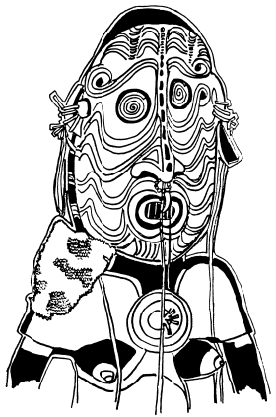
Orator’s stool, plus enlarged detail, from the Middle Sepik.
Private collection, USA.
Purchased in 1962 from a New York artefacts dealer.

Drawing by Professor Ruff of an orator's stool from Tambanum village of the Sepik.
According to information given Wallace Ruff in 1978 by men of the village, this figure was carved before the time of the Japanese invasion of the village during World War II.
The old men state that when Japanese entered the village they ordered that traditional carvings be thrown into the river (presumably to illustrate the new authority and to enforce abandonment of old customs).
This carving was later saved and, after departure of the Japanese, returned to its place in the ceremonial house.

Orator’s stool observed in Nangulimbit, one of the three small haus tambaran in the village of Brugnowi, 1977.
Carved by Abel Saun (grandfather of Saun) a resident of the village.
Brugnowi is a village of the Iatmul people, the furthest to the west, separated from central and western Iatmul by villages of unrelated groups.
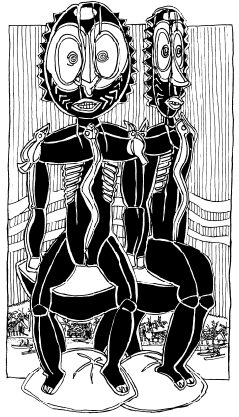
Orator’s stool from Brugnowi village.
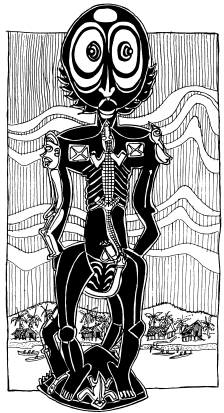
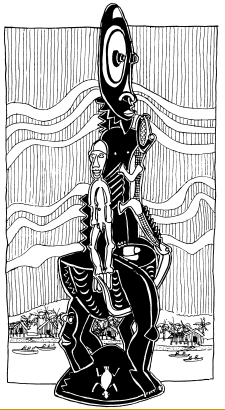
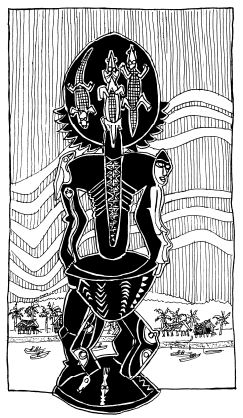
Orator’s stool from Brugnowi village carved by Saimboka, 1977.


Over modelled faces on three Tumbuna figures, Nagosap village, 1974.
Oil from a special tree is mixed with clay and a small quantity of lime to form a greasy "plaster" which can be moulded to form facial details.
Square cutouts in the framework allow the wearer’s arms to protrude from the mask.
The dancer’s eyes are behind the middle or lower part of the mask so the creation looms 6 to 7 feet in height.
Another entry identifies these as wicker dance costumes.
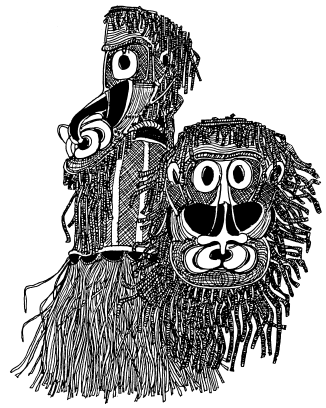
Wicker Tumbuna figure from Tambanum village.
Observed at the Village Arts Shop in Port Moresby - run as a sales outlet by the Government of Papua New Guinea, 1979.
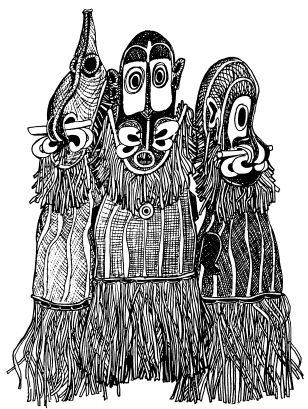
The wicker Tumbuna dance masks observed in 1978, in the PNG Government owned sales outlet for Village Arts in Port Moresby.
Of recent manufacture, they were designed for sale to tourists but adhere remarkably to traditional styles.
Wooden tusks would indicate that they may have originated in the Tambanum village.
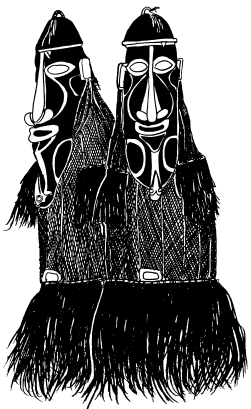
A wicker Tumbuna named Aulimbilaban obtained by capture from the old village of Tapmeiyui in the Yang’gol area.
Yambai of Tegoi village is its present owner.
As of 1981, a National Cultural Property designation is being sought for this artefact.
Craig, B - "Report for the Papua New Guinea National Museum and Art Gallery, of a Field Trip to the Sepik, Oct 19 - Nov 29, 1981", 1981, p 13.

Wicker Tumbuna observed in the upper floor of the Yentchan village haus tambaran Nyang’garambi in 1977.

A Wicker pig Tumbuna named Ibiyendanki, Kaminimbit village.
It was constructed by several men including Wolimbela, Nyagna and Monchi - all of the Aulimbit group.
The men indicate that the pig was made about four generations ago for the group’s Kandere (i.e. kindred on the mother’s side - uncle, cousin, nephew, etc.).
The figure is owned by Lukasambu of the Abelam clan.
Craig, B - "Report for the Papua New Guinea National Museum and Art Gallery, of a Field Trip to the Sepik, Oct 19 - Nov 29, 1981", 1981, p 9 (39) & p 110 (1).

Enlarged details of a Tambanum village Saunman figure from 1978.
Private collection, USA.
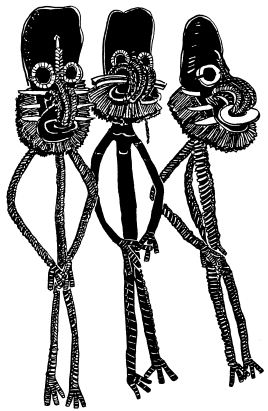
Grouping of Saunman woven figures, Tambanum village.
Embellished with wooden replicas of pig’s tusks, shell necklets or cuscus fur, the figures are more playful in character than sacred objects.
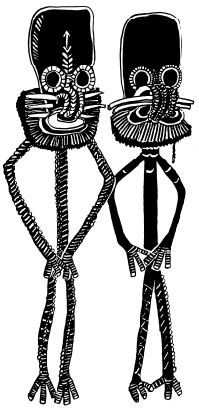
Tambanum village. Woven cane Saunman figure.
Made by Wangoui of the Mogwa clan in 1981.

Three Saunman figures, Tambanum village.
Unlike previous examples, which incorporated bast from the banana tree into the body portions, these are completely woven.

Enlarged details of the Tambanum village Saunman figures in the previous entry. Showing intricate construction, finely plaited eye detail, wooden tusks and fibre fringe embellishments.

Two views of a woven fibre mask named Kanjingawi, Kararau village, 1981.
The construction is topped by a bird of made from fibre and wood.
It was constructed by Beat Yang.

Crocodile constructed of fibre at the Timbunke village haus tambaran in 1978. The figure is named Kabalum, and is owned by Jori of the Kinjin clan.
The figure is stored in the rafters at the rear of the house. Its use is similar to that of one seen in Yetchan, where the lower jaw is hinged to move as men bearing the head-dress dance to Kundu music - giving the impression that the creature is “devouring” it prey.
Craig, B - "Report for the Papua New Guinea National Museum and Art Gallery, of a Field Trip to the Sepik, Oct 19 - Nov 29, 1981", 1981, p 31 (#37).

Ceremonial hat owned by the wife of Noah Kumot, Counsellor of Yentchan village.
Natural fibres twined with old shell pendants. The shells are attached with newer twine, so may have come from an older form.
Photographed in1981 while the owner was wearing the hat as part of her costume for Sing-Sings being staged for tourists from the Melanesian Explorer.

Various views of a recent mask from the Sepik displaying what Newton, D - "Oral Tradition and Art History in the Sepik", 1966 refers to as the "annular eye."
Wewak Cultural Centre sales outlet.

Two old stone-adzed Mwai masks with pig’s tusks, human hair and cowrie shells embedded in a gum matrix.
Named Molimindi and Molinjoa.
Both were carved by Moli’ula of the Leng’ga clan. The carvers were descendants of Kararau people who settled in Kaminimbit five generations ago. The masks are now owned by Wang’gi Gyambam. Craig, B - "Report for the Papua New Guinea National Museum and Art Gallery, of a Field Trip to the Sepik, Oct 19 - Nov 29, 1981", 1981, p 110.

A construction of tapa over a rattan frame, high on the back wall of the Yentchanmangua haus Tambaran, 1978.

Torembi gable mask, 1980.

Middle Sepik gable mask, 1974.

Wooden replicas of overmodelled skulls, Suapmeri village, 1974.
Previously real skulls were often placed in small windows cut in the facades of haus Tambaran structures.
Banned by mission and Government from acquiring real skulls through warfare, men of the Sepik often carve substitutes.

Splashboard for a canoe.
Carved by Abel Saun, grandfather of Saun, current resident of Brugnowi village.
Stored in one of the small local haus tambaran.

A carving made on the bark skin of a tree believed to be from one of the Sepik tributaries.
Observed in the Wewak Cultural Centre, under the direction of R. Wyatt in 1975.

Shield from the Chambri area.
Private collection, USA. Purchased from Father Heinemann, Wewak Catholic Mission, 1967.
It is nearly identical to a shield pictured in Mead, M - "The Mountain Arapesh" Vol. II, American Museum of Natural History, New York, Pocket ed., 1940, plate 5, dated 1938, labeled "wood shield. Tchambuli, (imported from the south)".

Two views of a mask carved in the old Hunstein (range) mountain style.
Made by the father of Wafiyo Makafa, Lake Wagu, 1978.

Two views of a mask, from the Bahinemo group of Lake Wagu, 1978.
From Gahom.

Front and profile views of two ceremonial masks in the haus tambaran at Lake Wagu, 1979.
Created by men who had migrated to the Sepik area from the Hunstein mountain range. The hook forms represent "hornbill beaks". Orange clay, grey, white and black earth pigments were used.

Carved lug of a Garamut named Mababilan, from Mindimbit village. The present prow and stern are recently carved and bolted onto the old drum body.
Iron pieces mend joints on one side of the drum.
The original prow is pictured in Bateson’s "Naven", Plate IX. Craig, 1981, p 15 (1).
Caption in "Naven" states: "Pair of slit gongs in Mindimbit. The carving represents heads of prawns with their rostra. The interest in noses gives a special importance to such totemic ancestors as possess conspicuous noses, e.g. sago weevils, prawns, etc." Bateson, G - "Naven", Cambrige (Stanford University Press reprint, Palo Alto, 1958).

Two views of the carved lug, of a Garamut named Nauwang’gawi, Kaminimbit village. It was carved by several men, including Palakban’gu, Kugului, Nogwangalabi and Ambundimi, all of the Abelam clan.
The prow design is that of a face (Savi), with a wallaby head on its brow. The drum was carved five generations ago. When the carving was completed, two men of Kanganaman were killed, and the drum was painted black; then the bodies of the victims were used as rollers to pull the Garamut into the cult house.
Notches along the slit near the prow, represent the tally of enemies killed. Avien, now about 60-65 years of age, is the current owner.
Craig, B - "Report for the Papua New Guinea National Museum and Art Gallery, of a Field Trip to the Sepik, Oct 19 - Nov 29, 1981", 1981, p 113 (10).

Two views of the prow of the Garamut called Ang’gumal, Kaminimbit village.
Carved with stone tools by a forgotten ancestor five generations ago, it was made at an old inland site in the bush, at a place named Maimdang’gan.
The drum is now owned by Bowi of the Abelam clan.
The prow design incorporates a prawn head and the face of a man. The stern represents a crocodile tail.
Craig, B - "Report for the Papua New Guinea National Museum and Art Gallery, of a Field Trip to the Sepik, Oct 19 - Nov 29, 1981", 1981, p 112 (6).

A Garamut named Yimbandauwa, Wolimbit haus tambaran, Kanganaman village.
The drum was made with stone tools, several generations ago. It is owned by Mbalat of the Samiaguat clan.
The prow design is that of a prawn. The craving at the rear is of the faces of the woman Sepalakwa and of the head of a sea animal "which lives in its shell".
Craig, B - "Report for the Papua New Guinea National Museum and Art Gallery, of a Field Trip to the Sepik, Oct 19 - Nov 29, 1981", 1981, p 84 (1).

The carved stern lug on the Garamut Kong’gunovwhei (Kongunwopei) of Wolimbit haus tambaran, Kanganaman village.
The prow design represents a mythical fish with a double nose. The stern is a female figure with a cicada’s nose.
The drum was made with steel tools by Meri-Kinjun (Malikinjin) of the Meyambei (Miembei) clan.

Painted designs along the side of an old Garamut drum named Gaugen in Wolimbit haus tambaran, Kanganaman village.
It was carved with steel tools by Mlen of Yamok village. It belongs to the Welkam clan, and was first purchased by Samowan, and is now owned by his son Pan.
Craig, B - "Report for the Papua New Guinea National Museum and Art Gallery, of a Field Trip to the Sepik, Oct 19 - Nov 29, 1981", 1981, p 86 (10).

Garamut drum.
The Iatmul style motifs indicate its middle Sepik origin.
Purchased in 1967 from Father Heinemann, Catholic Mission, Wewak.

Garamut drum observed in the Yentchanmangua village haus tambaran, 1978.

Avatip village Garamut drum, 1978.

Ruff’s impressions of an Avatip Garamut drum, taken from an old photograph.

Various views of a Brugnowi village Garamut drum named Akudimi, 1977.

Gable decoration often termed "ridge tile" in early publications.
Seated male figure surmounted by "fish eagle", Aibom village, 1967.
Women create the bowl base, then men model the bird and man figures.
"These ceramic sculptures are placed on top of the men’s house gables..." May, P & Tuckson, M - "The Traditional Pottery of Papua New Guinea", Sydney Bay Books, 1982, p 235.

Two views of a clay gable decoration, Aibom village, 1967.
Ochre, white and charcoal paints delineate the features on both the man and the bird.
The 'pecked' design over the shoulders and chest of the figure is an imitation of ceremonial scars.

Pottery from Aibom village, 1974.
Three sago storage jars are at the front and a pottery house finial with bird and man forms atop an inverted Sospen are at the rear.

Composite of motifs from a group of "roof tiles". Aibom village, 1967-1975.

Sago storage jar made by Maibalakui Kikoli (Father’s name), Aibom village, 1978.

Composite of bird faces on storage pots, Aibom village.

Enlarged details of bird figures from sago storage jars, Aibom village.

Piquant faces on sago storage pots, Aibom village.
Women potters have a wide market for their cooking hearths and storage pots, which are traded for long distances up and down the Sepik.

A small pot similar to one illustrated in May, P & Tuckson, M - "The Traditional Pottery of Papua New Guinea", Sydney Bay Books, 1982, Fig. 1.23, p 23 and designated "Chalice, made for use in the Catholic church, Aibom".
This example dates from 1974.

Three views of a small clay pot of uncertain use, Aibom village, 1967.
Produced about the time a United Nations pottery expert was advising the women on production, when many small uncharacteristic forms were produced.

Abstract motif from a wooden bowl, made as a replica of a Koiwat pot, Timbunke village, 1978.

A Sawos conical eating bowl of Koiwat, embellished with a traditional pattern. This example was purchased in Wewak, in 1974.
Refer to Kelm, "Kunst Vom Sepik", Veroffentlichungen des Museum fur Volkerkunde, Berlin, 1966, #322 to 348 for a comparison to old bowls from the Sepik expedition of 1912/13.
These examples illustrate how faithfully details of the Koiwat pots are maintained and recreated today.
May, P & Tuckson, M - "The Traditional Pottery of Papua New Guinea", Sydney Bay Books, 1982, p 229, also concludes that, "The artists are drawing upon a reservoir of patters and combinations of elements prescribed as formulae within the social structure of the Sawos people. There is no evidence of artistic license or innovation of design or form, as has occurred amongst the Aibom, Dimiri-Marawat and Wosera industries."
Bowls are made by women, and decorated by men by "chip carving."

Three views of a smoke pot, Dimiri village, 1978.
The small crocodile figure in the foreground is also made from clay.
Fanciful figures of human and animal forms were termed "bransi" by the villagers, but no translation of this term was available.
May, P & Tuckson, M - "The Traditional Pottery of Papua New Guinea", Sydney Bay Books, 1982, p 242, indicate that "modelled forms of faces, frogs or tortoises...are not traditional..."

Clay heads in imitation of overmodelled skulls, Korogo village, 1967.
- Facial details are painted in black, over a dark red surface.
- Real hair has been inserted into the heads.
- Cassowary bone daggers support the heads.
- Eyes are of shell.
Private collection, USA.

Swagup ceremonial house during the high water season.
According to Newton, D - "Crocodile and Cassowary", Museum of Primitive Art, New York, 1971, this is the house named Amuwasi, of Nggraiyo Ward, Yutam clan.

Ruff impressions of the Bangwis village haus tambaran Waypanal in the Waskuk area.

Two Nagwi figures from the Kwoma area.
Observed in 1981 at the Melanesian Arts Centre, Lae, PNG.

Interior details of the beams and lashings behind a major support in the dwelling of Marik, a big man of Waskuk village.
Kwoma area, 1975.

A carved and painted mask made by Marik, a big man of Waskuk village.
Used in association with yam harvest ceremonies.
Observed, 1974.

Three views of a Waskuk village Yina figure, observed in the Village Arts sales outlet of the National Cultural Council of PNG in 1974.

A carved figure formerly in the collection of an Ambunti collector.
It was carved more than twenty years ago by the local people.
Early artefacts buyers refused to buy it because, "it was ugly." It was sold by the owner in 1979, "For a good price," to a European tourist.

Top and profile views of a Waskuk Garamut drum, 1977.
Marik, the big man says he carved several of the drums within the ceremonial house. While the new ceremonial house was under construction, the drums were placed under shelter in an adjacent shed.

Garamut drum, Waskuk village, 1977.

This Garamut drum was observed in haus Tambaran #1 of Tongwinjamb village in 1978.
Kaumindja Yumanumbur says he carved this ceremonial drum in 1945.

Painted motif on the Ambunti Kalabus (Prison).
Observed in 1967 as prisoners were being released for their grass cutting duties.

Painting on palm spathe, Waskuk area.
Collection of the Papua New Guinea University of Technology, Lae, PNG.
Collected and donated in 1979.

Bark painting motifs from the Ambunti courthouse.
Painted in 1976, by many men of Tongwinjamb, Waskuk, Bangwis, Marawei, Warimbanj and related villages.

Bark painting from the interior of the Marawei village haus tambaran, Ningindu, 1978.

Another painted bark panel from the Ambunti courthouse, 1976.
Kaumindja of Tongwinjamb village indicated that he and three other Waskuk men served as "instructors" for men painting the bark panels in the council chamber and courthouse.
Now, he says the young are "fresh," and don't know the techniques required for bark painting.

A cult object made from clay and then modelled and painted, Malu village, 1975.
Such objects are associated with yam harvest ceremonies.

A cult object from Malu village.
Adorned with paint and feathers, 1975.



Three views of a clay face pot belonging to Kaumindja Yambanumbur (father's name), Tongwinjamb village, 1978.
Below, two views of the carved stopper for the clay face pot.
According to the owner, these stoppers "kept the spirit from escaping" from the interior of the pot, through the eye or mouth orifices.

Nuguma area face pot, Amaki, #1, 1978.
Dark charcoal color clay, with traces of lighter gray and dark red pigments.

Two views of a Brugnowi clay head cult object, declared to be made of stone by its owner the father of William Kiemali.
It is reminiscent of Kwoma/Nukuma cult objects, but the owner gave no explanation for its presence in a Iatmul village.

Motifs from an old lime tube, with a long notched stick, Tongwijamb.
Made by Kaumindja Yamanumbur (father's name).
His long tale of the meaning of the motifs used involved details of blak bokis (fruit bat) digestive systems.
This relatively large gourd had been deftly incised many years before the 1978 date of the conversation.

Kubkain war shields observed in 1977.
Carved by Nario, who indicated that the faces represent Tumbuna (ancestor), and the notched details a puk puk (crocodile).
"Smiling face" and notched details are typical for carvings from this area.

Ruff's impressions of Kubkain carved shields, 1977.

A small storage structure at Swagup, where recent carvings were displayed in preparation for the arrival of tourist buyers, 1977.


Garamut drum from Kubkain village, 1977.

Pei village shield, 1977.

Kubkain shield.
In the collection of the McCarthy Museum, Goroka, PNG.

Upper Sepik (Kubkain area?) shield observed about 1979 in the Village Arts (a Government owned artefacts store) in Port Moresby, PNG.
Believed to have been collected by Betty Thomas, who at that time was in charge of the store.

Kubkain area shield observed for sale in Ambunti, 1980.

Burumai village bark paintings.
Paintings are on separate pieces of palm spaeth, lashed together, and are used to decorate the haus tamburan, Iwam.
After Schuster, M - "Fabre, Motiv, Funktion", Museum fur Volkerkunde, Basel, Switzerland, 1969, p 7, #7.

Shields from the Hunstein mountain area, 1976.
Collected by Alan Gallagher, old time resident and artefacts dealer of Ambunti.
Private collection, USA.

Motifs on a bark panel from Burumai village.
Adapted from Schuster, M - "Fabre, Motiv, Funktion", Museum fur Volkerkunde, Basel, Switzerland, 1969, #9.

Recently carved shield from Oumi (Auni?) village.
According to the informant, bird's wing and bat's wing motifs were incorporated.
Painted designs are yellow ochre, black and white, 1977.